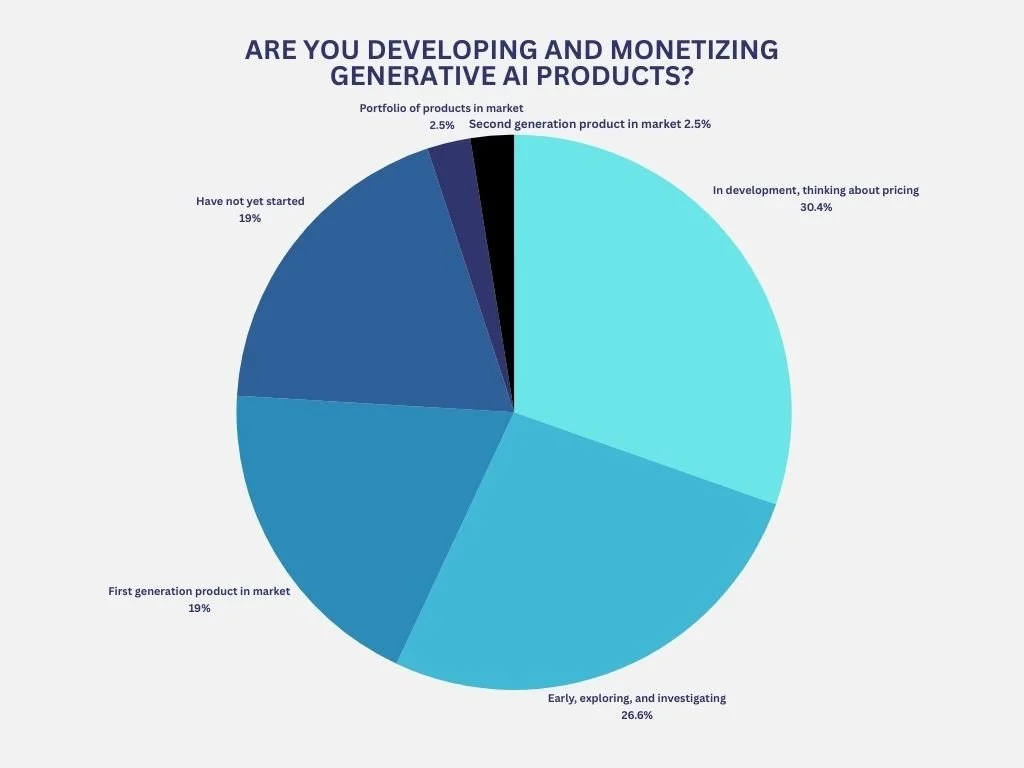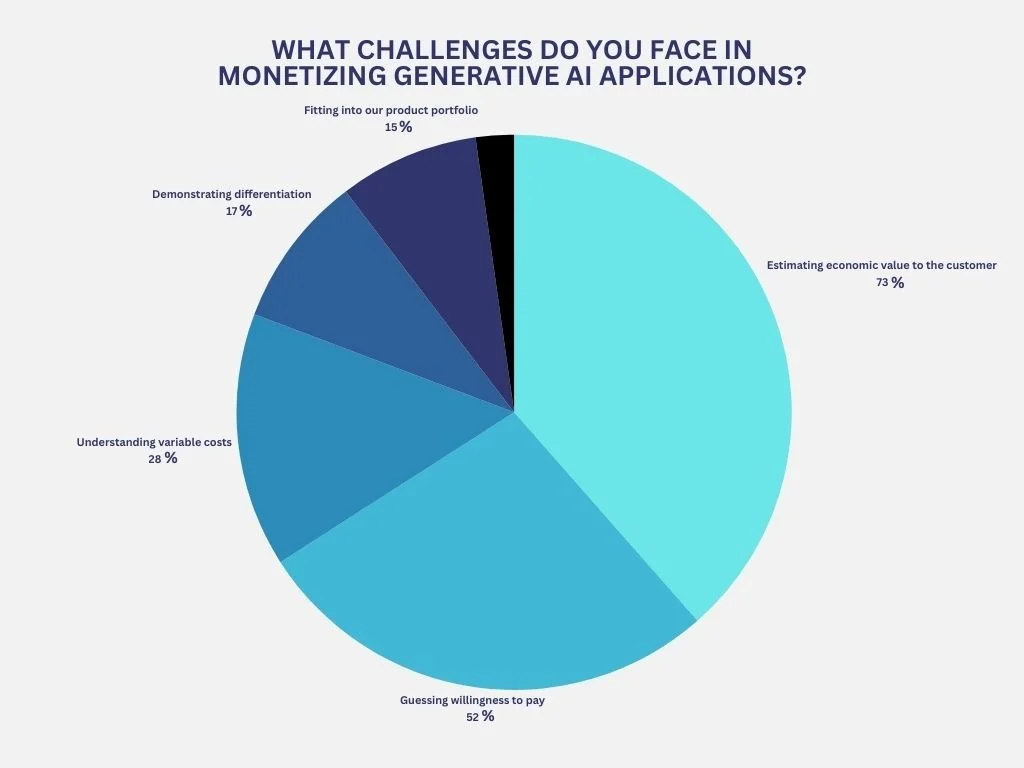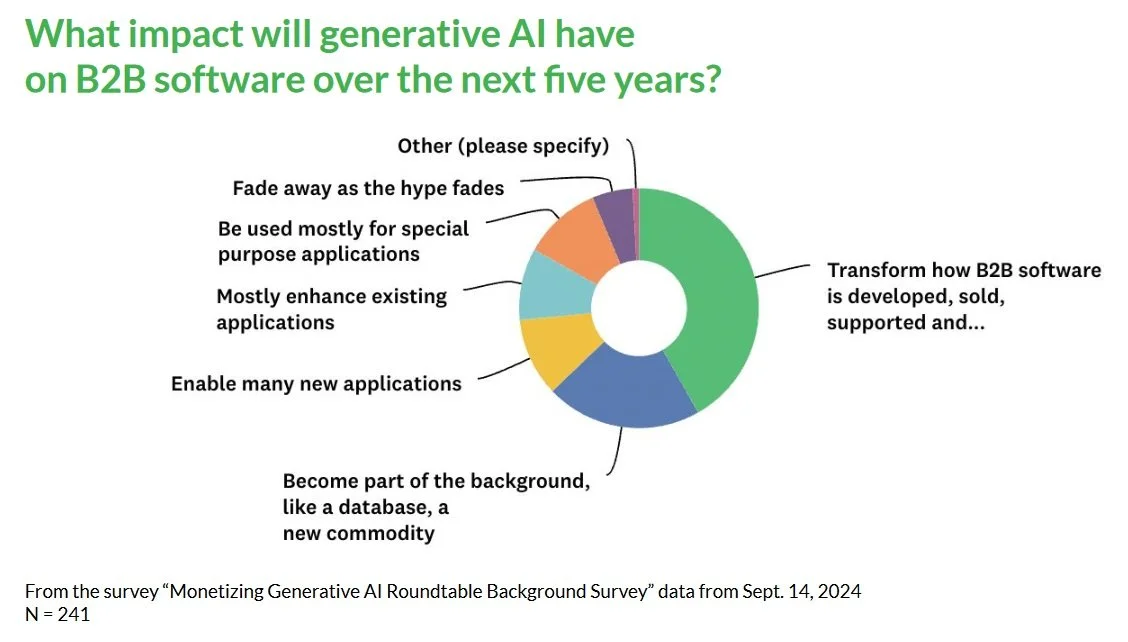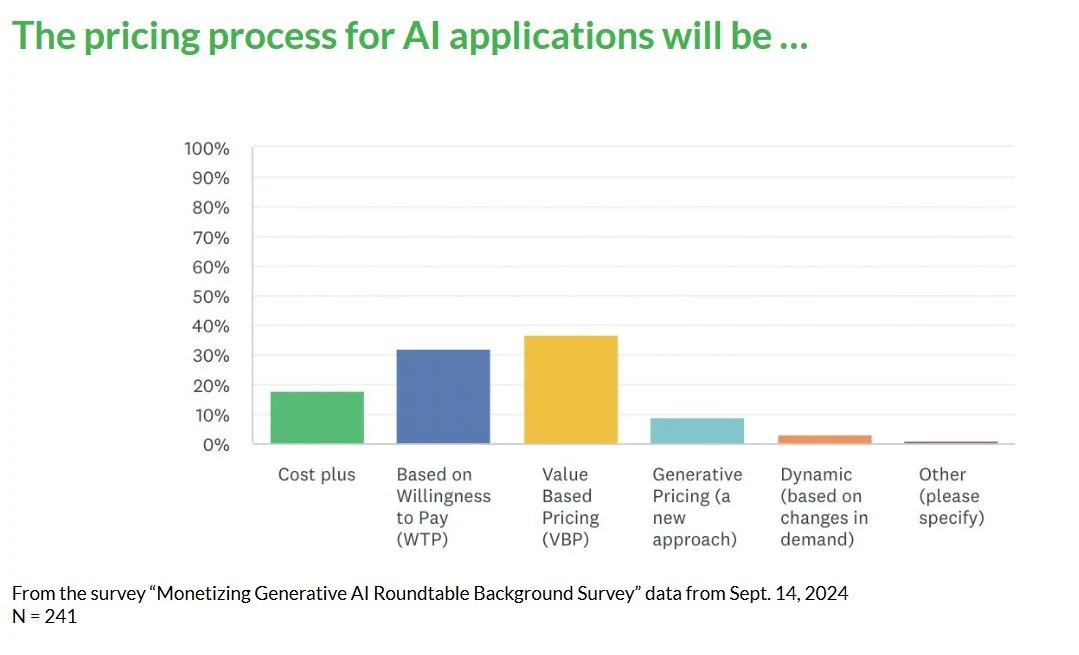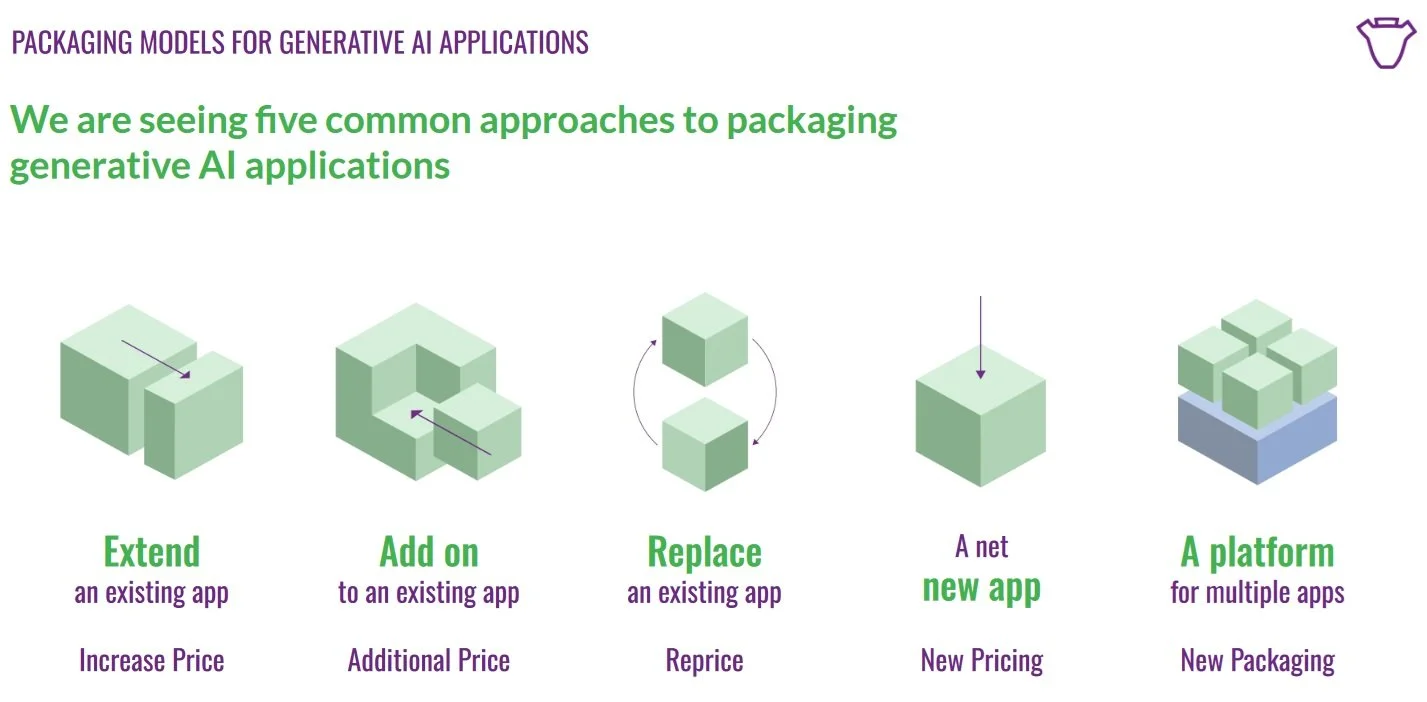Monetizing GenAI Roundtable Webinar: On-Demand Recording
Liam Hannaford is the Marketing Manager at Ibbaka. Connect on LinkedIn
Thank you to all who registered and joined our Monetizing GenAI roundtable discussion last Thursday.
Even if you signed up and couldn’t attend, we have the webinar recording available for you right here.
"Pricing an AI product will be a defining question in software for the next few years. AI products offer productivity gains. But greater productivity may reduce the demand for seats over time, ultimately decreasing the size of software markets.” - Tomasz Tunguz, July 11, 2024
Insights from Our Monetizing GenAI Roundtable
Ibbaka had the pleasure of hosting an enlightening roundtable discussion on Monetizing Generative AI, featuring two industry luminaries: Michael Mansard from Zuora and Kyle Poyar from OpenView Partners.
Michael Mansard, Principal Director of Subscription Strategy at Zuora and EMEA Chair of the Subscribed Institute, brought his extensive experience in subscription economy strategies to the table. With a background that includes guiding over 400 companies towards new business models, Michael offered valuable insights into the challenges and opportunities of GenAI monetization.
Kyle Poyar, known for his work at OpenView Partners and the author of "Growth Unhinged," complemented the discussion with his expertise in SaaS growth strategies.
Generative AI is going to transform how we build B2B applications, how we configure them, how we move to dynamic configuration, and all of that is going to have a huge impact on both monetization and pricing.
What we thought of best practices in the past is going to change.
Key Poll Findings on Development Stages and Monetization Hurdles from the Roundtable
Let's break down our results:
Poll 1: ”Are you developing and monetizing generative AI products?”
75%+ of respondents are in the early phases, with
In development, thinking about pricing: 30.38%
Early, exploring, and investigating: 26.58%
First generation product in market: 18.99%
Have not yet started: 18.99%
Portfolio of products in market: 2.53%
Second generation product in market: 2.53%
This distribution indicates that generative AI is still an emerging field, with most companies in the planning or early implementation stages.
Poll 2: ”What challenges do you face in monetizing generative AI applications?”
Estimating economic value to the customer: A significant 73.24% struggle with estimating the economic value to customers, underscoring the complexity of quantifying AI's benefits.
Guessing willingness to pay: 52.11% find it challenging to determine customers' willingness to pay, reflecting the novelty of generative AI solutions.
Understanding variable costs: 28.17% face difficulties in understanding variable costs, likely due to the dynamic nature of AI resource consumption.
Demonstrating differentiation: 16.90% struggle with demonstrating how their offering stands out, indicating a potentially crowded or rapidly evolving market.
Fitting into our product portfolio: 15.49% find it challenging to fit generative AI products into their existing portfolio, suggesting potential disruption to established business models.
Other: 4.23%
Key Takeaways in our Monetizing Generative AI poll
The generative AI market is in its early stages, with most companies still developing or exploring their offerings.
Determining the value proposition and appropriate pricing for generative AI products remains a significant challenge.
Companies need to focus on clearly articulating the economic benefits of their AI solutions to customers.
Understanding and managing the variable costs associated with AI applications is crucial for sustainable monetization.
As the market matures, differentiation and seamless integration with existing product portfolios will become increasingly important.
These insights highlight the need for innovative pricing strategies and a deep understanding of both customer value and operational costs in the rapidly evolving generative AI landscape.
We will go deeper into this analysis with a new blog, so keep your eyes peeled.
Throughout the discussion, Ibbaka’s Steven Forth went over a few questions from our mini-GenAI survey (it closed on Thursday, September 19th) and nearly 50% of respondents believe within the next 5 years, generative AI will transform how B2B software is developed, sold, and supported.
Optimizing pricing strategies for value creation
Traditional SaaS user-based pricing models may not be sustainable for GenAI offerings, given the technology's unique cost structure and profitability requirements. However, a purely cost-driven approach could make pricing opaque and unpredictable for customers.
Rather than relying solely on cost-based or adoption-focused tactics, our panelists believe companies should leverage value-based monetization strategies that have proven successful across industries in driving recurring revenue growth.
Value-based pricing involves setting prices primarily according to the customer's perceived or estimated value of a product or service, rather than just production costs or competitive positioning. This approach helps align pricing with customers' willingness to pay. Implementing monetization early on therefore sends an important signal about the value proposition.
We can see below that just under 40% of respondents believe and feel that the pricing process for AI applications will be going through the value based pricing route, with just a little more than 30% saying they’ll be priced on willingness to pay.
Below are the 5 different patterns in how people are packaging generative AI applications. Michael has important thoughts on what’s happening in the market as well - we’ll dig deeper into this very soon.
The 5 Common Approaches to Packaging Generative AI Applications
Open Questions
● What impact will generative AI’s higher variable costs have on pricing and operating models?
Kyle: I think there are a couple of ways of looking at it. From a funding standpoint, if you have the balance sheet and you believe costs are going to come down materially, or that you need some initial adoption to build that product that’s going to win in the market. You’re probably not worried about cost, you’re more worried about adoption and creating value for customers. There is a sizable part of the market that has that mentality, and it’s fine with potentially negative gross margin products, or having customers but negative gross margins, in order to hopefully unlock a bigger opportunity in the future.
● Will GBB remain the dominant packaging model?
Michael: My view, and this is just a prediction, GBB will remain an important model in the future, but that may not be the main entry point. The future may be more genAI or AI-driven packaging. Even the NY Times does dynamic packaging. I think this consumer approach to packaging might appear in B2B and I think GBB may not be in the future. I was a big promoter of GBB when I invested in startups.
Closing Thoughts
Kyle, Michael, and Steven shared some final thoughts towards the end of the roundtable around product adoption, having your monetization strategy play a pivotal role, and the importance on demonstrating and articulating value that your product brings to the user.
Rethinking User Adoption
Consider carefully the user adoption journey for your product and offerings. It's crucial to ensure that users have sufficient opportunities to engage with your offering and experience tangible returns on their investment. The key is to create a product that becomes indispensable, encouraging continued use and integration into their daily workflows.
It’s pretty clear that your monetization strategy plays a pivotal role in shaping user behavior. Traditional pricing models, such as per-seat licensing, can inadvertently lead to undesired outcomes. Users might resort to sharing logins or limiting access to control costs. Similarly, usage-based pricing can create a 'meter-running' effect, where users become overly conscious of each interaction with the product, potentially limiting its use and value.
Money matters (more than you think)
While articulating value and demonstrating ROI is undoubtedly important, it's equally crucial to understand the psychological aspects of user adoption. Consider how your pricing structure influences user perception and long-term engagement. The goal is to align your pricing model with the value users derive from your product over time, encouraging full utilization without creating barriers to adoption or usage.
Learn how our innovative B2B SaaS solution can assist you in effectively monetizing your AI solutions and staying ahead of the competition.
Further Reading on Generative AI, AI Pricing, Monetizing AI, and More…
Early Insights from the Monetizing Generative AI Roundtable Survey
Only 15% of Companies are Monetizing their AI Solutions…What’s Your Strategy?
Comparing the Pricing Pages of AiSDR, Reply.io, and Smartlead.ai
Understanding how generative AI SDRs are revolutionizing sales development
Harnessing the power of generative AI for creating rubrics for scoring proposals
Generative AI Monetization: An Interview with Michael Mansard
What are the emerging value drivers for generative AI agents and how will they be priced?
AI Pricing: What does Box AI tell us about AI pricing trends?
AI Pricing: Will the popularity of RAGs change how we price AI?
AI Pricing: Operating Costs will play a big role in pricing AI functionality
AI Pricing: Early insights from the AI Monetization in 2024 research
AI Pricing: Has Microsoft Copilot set a reference price for other Generative AI Applications?
Pricing AI assistants for productivity suites: Survey Results
What ChatGPT has to say about pricing for product-led growth (PLG)




